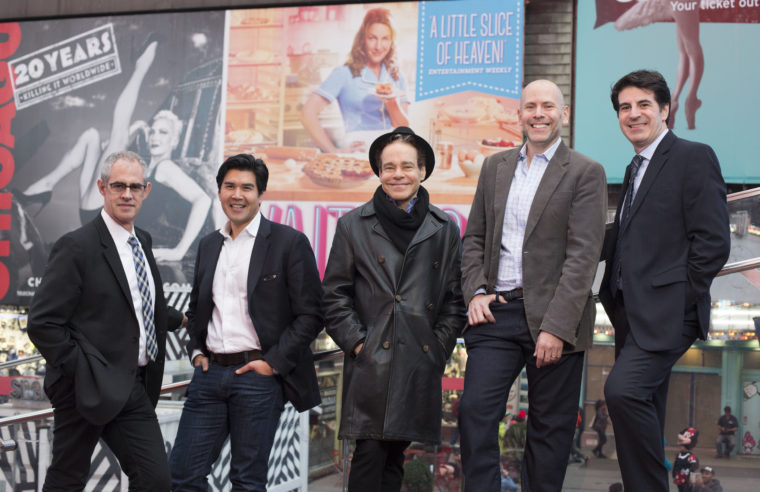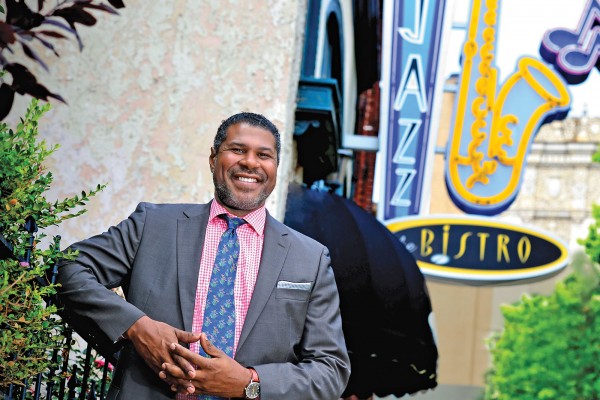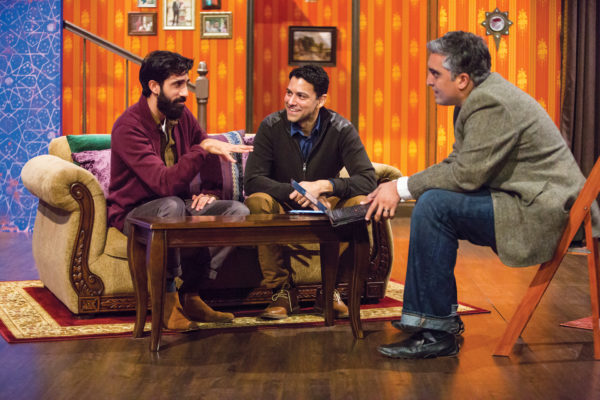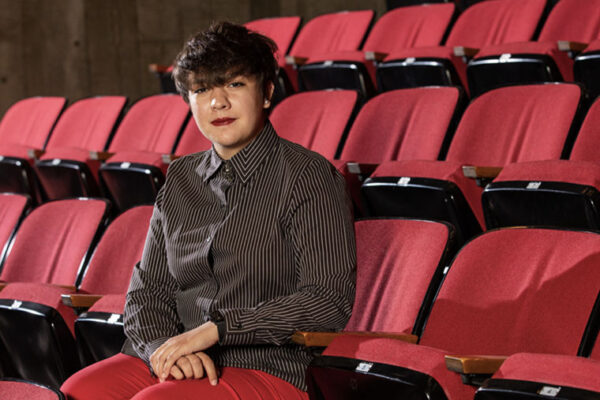We talk about Broadway as though it’s a vast place, its marquees’ stars rivaling the night sky. But in reality, the Great White Way is a strip two blocks wide and 14 blocks long, and it contains only 40 theaters.
That said, this small slice of Manhattan has a boundless attitude.
Think about it: Musicals can often cost up to $30 million to mount. Shows like Fun Home and Hamilton play at the edge of society. Investors are so passionate (or crazy) that they keep pouring money into shows, knowing only one in five recoups its costs. And, truthfully, actors and directors would have a far more comfortable life, in every sense of the word, if they switched careers.
But they wouldn’t dream of it. They work in the most glamorous, adrenaline-charged field in America, and they all know each other, as we found when we talked to seven WashU alumni currently working on Broadway.
“Who else are you talking to? Oh, yeah, sure, I know that guy. I forgot he went to WashU too.” Pun Bandhu, AB ’96, and Terry Schnuck, MBA ’60, for example, were co-producers of Spring Awakening — a Tony Award winner written by another WashU alum, Steven Sater — and its airing of teenage sex and rebellion paved the way for shows like the Tony-winning Fun Home, co-produced by Schnuck and Mary Strauss, MA ’69.
On go the connections. Back in college, for all seven, Broadway was a faraway dream. But they made it. No matter where they’ve settled, emotionally, Broadway’s where they live. And with every production, these WashU alums leave their mark.
Steven Sater
A poet, playwright, lyricist and screenwriter, Steven Sater recently reinvented Alice in Wonderland (Alice by Heart, commissioned by the Brits’ National Theatre), wrote a play around Mahler’s “Songs on the Death of Children” (No One’s Sonata) and penned the screenplay for his Tony-winning Spring Awakening. He is matching words to Burt Bacharach’s first original score in years (Some Lovers), writing a play commissioned to accompany Hamlet in repertory, adapting his play New York Animals for British TV, launching a new version of the 19th-century Austrian play La Ronde, working on Murder at the Gates — a teen murder mystery/rock musical with British rock star James Bourne — and writing a novel.
The novel is, he’s realized, a way of remaking what he lost during his sophomore year at WashU. An English literature major, he’d written a day-in-the-life of himself and his teacher, modeled on Joyce’s Ulysses. The manuscript burned when his apartment caught fire.
Sater shattered multiple vertebrae jumping from his balcony to escape the flames. Strapped to a narrow bed and turned like meat on a spit, he distracted himself by clenching a page-turner between his teeth and, page by page, teaching himself ancient Greek. Had he not, he says, there would be no Spring Awakening: The Greeks made him understand that songs can forward a story in the way their choruses once did. In the wake of the Columbine shootings, he used that knowledge to turn an 1891 German play about the loss of innocence into a rock musical.
“The play was an outcry against social and religious hypocrisy. It was full of the yearnings of young people, and rock music had, for generations, been the outlet for that.”
— Steven Sater
“The play was an outcry against social and religious hypocrisy, against parents who paid no attention to what was going on in the hearts of their children,” he says. “It was full of the yearnings of young people, and rock music had, for generations, been the outlet for that.”
Spring Awakening has since been performed in 52 countries. In 2015, it was revived by the Deaf West Theatre and became Broadway’s first commercial production of a deaf theater company’s work.
“It was genuinely moving,” he says. “In a way, the words became more primary. The choreography all came from the signs for the words: The words were becoming pictures before the audience’s eyes, and the songs became the dance.
“One thing Broadway allows you,” he adds, “is to set a sort of imprimatur on a play. By being part of the Broadway landscape, you become part of a larger cultural conversation.”
It was Sater’s parents who insisted on a liberal arts education — he’d wanted to go straight to a drama school. Instead, he went to WashU and then on to Princeton to do graduate work in literature. Today, his apartment is strewn with notepads (he writes longhand), Shakespeare editions, Tolstoy and Homer and Proust.
“I don’t think Broadway is like Ancient Greece at all,” he says. “We have lost that impulse of going to a theater as if to a temple, to cleanse our culture and to restore ourselves. Broadway is, of course, a commercial enterprise. And ticket costs are out of control — because the costs of mounting a show are so steep. Still, a single work can break through from Broadway to touch the heart of our country and make a big difference.”
Terry Schnuck
Terry Schnuck won’t invest unless a show resonates with him, and his favorites are shows, like Spring Awakening, that can make a difference. Broadway is intensely personal to Schnuck: He turned his life over to it at the age of 50, flabbergasting his family by leaving the Schnuck grocery business to finally follow his dream. He’s since poured both his heart and his money into more than 26 Broadway and Off-Broadway shows, five of them Tony winners.
How does he pick so well? “Oh, you only hear about the good ones,” he says with a grin. “I’ve had plenty of others. But you go with your gut, and you learn with each one.”
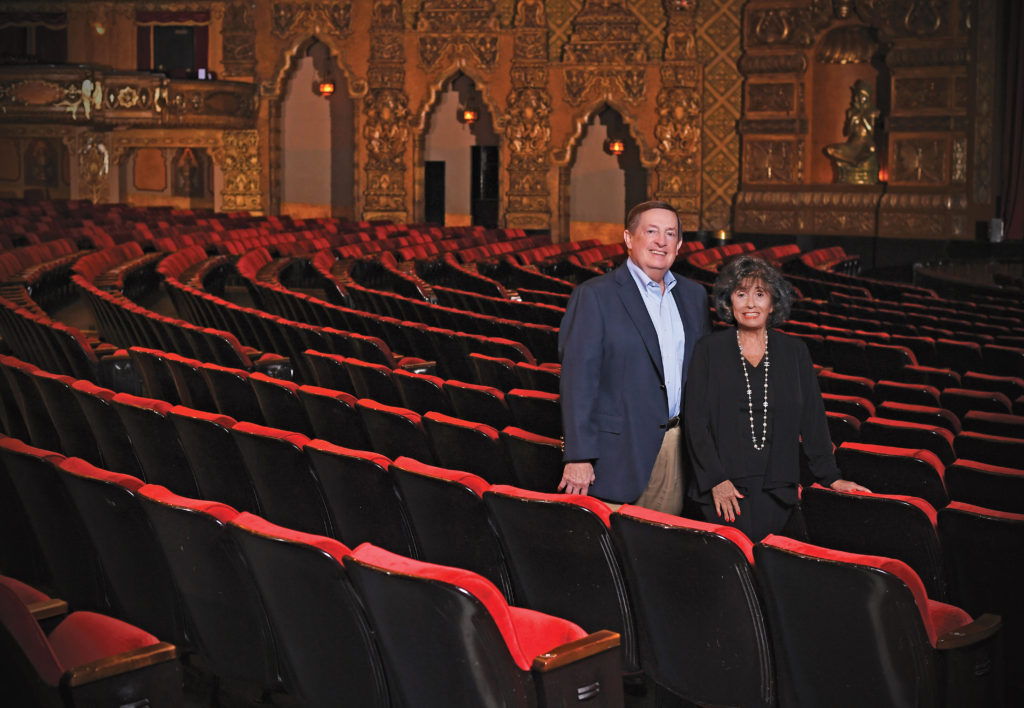
He first saw Falling at the Mustard Seed Theatre in St. Louis. Written by Deanna Jent, a professor at Fontbonne University, the play is about a family that includes a severely autistic 18-year-old boy. “The theme is, how do you love someone who is hard to love,” he says. “I saw it and thought: ‘Man, other people have to see this show.’”
His sense of urgency was so great, Schnuck took Falling straight to New York instead of mounting it as a regional production, which would have taken more time and lost him a little control. “We didn’t make a cent, but it’s the show I’m proudest of producing.”
It also had one of the best opening nights, Off-Broadway in Greenwich Village: “Earlier in the day, we’d gotten a copy of a great review by Rex Reed,” he says. “I was encouraged by my press guy and general manager to read it at the opening-night party, which was so old school; reading reviews is not done anymore, because nowadays they go online immediately after the show. I read it standing next to a grand piano; I felt like an old-time impresario.”
The after-party that was pure fun, though, was for Martin Short: Fame Becomes Me. “It was at Tavern on the Green, and he had all his friends there, including Tom Hanks and the guys from Saturday Night Live. I still have pinch-me moments, and that was one of them.”
Schnuck flashed back to childhood: playing DJ in his bedroom, writing skits, putting on puppet shows. “I acted in college,” he says, “but I knew I wanted to raise a family someday, and I didn’t think you could do both well at the same time. So I put theater aside.” For 25 years.
During those 25 years, he earned a law degree and an MBA, and gave expert counsel to the family business. And every summer, he saw every show at The Muny in Forest Park. When he wound up on the Muny’s board, the old spark flared too high to ignore. “If I die without exercising the creative side of my mind,” he thought, “I’m not going to die happy.”
His family’s reaction? “At first they were shocked, and then they realized it made perfect sense. Now I think they’re enjoying my journey vicariously.”
Is producing as exciting as those limelit college days? “I didn’t think it would be,” he admits. “I was a character actor. You got all the immediate gratification, the adrenaline rush. But, today, I get a great sense of satisfaction, and a real rush, when a show opens.”
Schnuck’s latest winner was Fun Home, which he first saw with his daughter at the Public Theater in New York. The material was fresh and challenging — a memoir by a lesbian cartoonist who’s sure her funeral director father, a closeted homosexual, committed suicide — but in the end, “it’s about family,” he says, “and the secrets we keep from each other.”
Currently, he’s working on a musical called Bandstand, in which a World War II soldier comes home and enters a radio-station contest for swing bands. He’s as worried about the dialogue — “Would somebody have said it that way in the ’40s?” — as he is the financing. “If you’re involved in the project early, you can weigh in on the creative aspects,” he says. “Some songs may blow you away; others you might ask for a re-do.” (Bandstand is scheduled to open at the Bernard B. Jacobs Theatre in April.)
Pun Bandhu
Pun Bandhu, one of Schnuck’s fellow producers on Spring Awakening, talks on his dinner break; he’s in tech rehearsals at the Public, for the revival of Plenty by David Hare. In Bandhu’s WashU days, everybody figured he’d wind up in the diplomatic corps as an ambassador; he’d majored in political science and international studies, and he speaks five languages.
Theater bit, though, when Bandhu was a 5-year-old in Indonesia, watching the Jakarta International High School’s production of West Side Story. Like Schnuck, he did his own puppet shows, his inspired by the famous wayang kulit shadow puppets of Indonesia. At WashU, he performed in Performing Arts Department shows As You Like It and The Double Inconstancy, directed by Professor William Whitaker. He also collaborated with playwright Joan Lipkin on an original play, Stories from Generation XYZ, directed by Professor Annamaria Pileggi. Bandhu was also a part of the beginning years of All Student Theater. And at graduation, the truth hit: “I’d regret it for the rest of my life if I didn’t see how far I could take it.”
Bandhu went on to earn an MFA in acting from Yale School of Drama, and he has worked at theaters in New York and around the country, making his Broadway debut in 2011 in the revival of the Pulitzer-winning Wit. His Hollywood credits include the Oscar-nominated Best Picture Michael Clayton and the Coen brothers’ Burn After Reading. He started juggling a producing career in addition to his acting work when he formed ZenDog Productions in 2004 and brought together a network of investors to co-produce the revival of Glengarry Glen Ross, which went on to win a Tony in 2005. “That opened a lot of doors,” he says. “Spring Awakening was next, and it was so gratifying — it’s so highly artistic, of-the-moment and much more innovative than the typical, often fluffy, fare you see on Broadway.”
Bandhu is currently producing a documentary film called Real/Fake about the greatest master art forger of the 20th century, Elmyr de Hory, whose original creations masqueraded as Picassos and Matisses, among others, and caused unprecedented turmoil in the art world in the 1960s and ’70s. As to future ambitions, Bandhu returns to his first love: theater.
“The fact that the biggest cultural story right now is Hamilton says a lot. There are still certain things theater can do better than film or TV. It’s a forum for the debate of ideas, and there’s a catharsis involved. The best theater changes you.”
— Pun Bandhu
“I want to help tell more Asian-American stories, since there have been so few on Broadway,” he says. “There’s a huge renaissance in playwrighting right now, with so many talented Asian-American writers innovating the form.” Broadway, though, is tough. Bandhu says that not every great project belongs on Broadway — that it takes a particular alchemy to create a show that can fill 1,000+ seats every night. A show must have universal appeal, and it must be something that critics will support and that theater-goers will be compelled to recommend to 10 of their friends.
“Typically, Broadway is not water-cooler conversation,” Bandhu concedes. “But the experience that theater brings — of sharing a moment in a single place with a community of people, experiencing that energy transference between the actors and the audience becomes even more valuable in this digital world. It’s not downloadable; you have to be there. The fact that the biggest cultural story right now is Hamilton says a lot. There are still certain things theater can do better than film or TV. It’s a forum for the debate of ideas, and there’s a catharsis involved. The best theater changes you.”
Offering an example, he describes Plenty as “probably the best-written work in the English language about the crumbling of the British empire.” And his role in the play? He’s the Burmese ambassador.
Keith Sherman
Keith Sherman, BSBA ’77, grew up in Jersey, and the bus to New York stopped in front of his high school. “I’d cut classes on Wednesday, go to Times Square, buy an SRO ticket, and be back on the bus and home before dinner,” he says. At WashU, he majored in business, but he worked at Edison Theater. “Watching Kevin Kline and Patti LuPone perform, I was so deeply moved,” he says, “that all I could think was, ‘I want to be involved in that.’” Alas, he was “a terrible actor — a spear carrier, mainly.” So he found his niche helping theatrical clients convey their messages to the world.
His first job was “audience development” for the Roundabout Theatre. He worked for WashU alum David Merrick on the original production of 42nd Street, then formed his own PR company. He’s since represented more than 300 Broadway, Off-Broadway and touring productions. He did public relations for the Tony Awards for 18 years and for the entertainment division of Marsh & McClennan for a decade, represented famous theater illustrator Al Hirschfeld for the last 15 years of his life and represented the Royal Shakespeare Company. He currently represents the Drama Desk Awards.
But Sherman’s clients stretch beyond Broadway — to Masterpiece, The New York Times and the sports world (such as skater Brian Boitano). His favorites are “the ones who have their head screwed on right. There’s invariably a moment in any project when the dark clouds come in. The smart ones work through it. The others implode.”
Working through it together is key, because “everything about the theater is collaborative.” Sherman’s job is to strategize, to figure out how to get his clients into the greater media conversation. “You have to look at the elements of the creative team, what the show’s about, where it’s set, what its strengths are,” Sherman says. “Is there a star? Is the writer a star? The director? OK, nobody knows it — did it come from London?
“This is a business of passion,” Sherman says. “I’ve handled so many shows that in my heart I’ve loved but that have been dismissed by critics. It’s not an easy business. There’s only one constant, and that’s change. In New York City in the ’20s, there were 18 newspapers. I can remember a time when all the TV stations had theater critics. What we have today are dozens and dozens of websites that report about theater. What we have today are niches.”
What project would he love to publicize? “The next hit,” he says, laughing. “But it’s a crapshoot.” You never know what’ll go viral, in live-audience terms. “I’m handling an Off-Broadway musical right now called Cagney, and the tap dancing, the whole gestalt of it, just makes people happy.”
Michael Sinder
The entertainment lawyer negotiating contracts for Cagney happens to be Michael Sinder, AB ’90, JD ’93. For five years, starting around age 7, Sinder attended the American Academy of Dramatic Arts in Manhattan. “My parents would schlepp me into the city from the suburbs. It taught me so much about how to present myself in public. But I went to auditions and … I didn’t have it.”
In college, he majored in psychology, pre-law. His father was a lawyer; that would be his path too. Except he didn’t want to practice corporate law or courtroom law. He’d never heard of theater law, but he figured it had to exist. After working for a corporate firm and on Capitol Hill, he got his break: a job managing labor relations for what’s now The Broadway League, smoothing collective-bargaining negotiations with Broadway’s many unions. After that, Sinder worked several jobs in the theater industry, including as a lawyer with a boutique entertainment firm, a booking agent with the William Morris Agency and in-house counsel for a prominent team of Broadway producers. In 2014, he formed his own law firm.
“Broadway — it allows people to escape, but it also allows them to address some difficult topics. You can bring up some topics that people wouldn’t otherwise be able to talk about around the dinner table.”
— Michael Sinder
Live theater is magic, he says. “A Broadway audience leans in. When you have live actors onstage, there really is an energy going back and forth. You can hear the actors breathing; you can see them sweat. In a movie theater, people are slumping in their seats, leaning their heads back.” Another difference is the atmosphere: Hollywood can be ruthless, but “there’s a connection that runs through the whole theater community, whether you’re a lawyer or a stagehand or a director.
“Broadway — it allows people to escape, but it also allows them to address some difficult topics,” Sinder says. “You can bring up some topics that people wouldn’t otherwise be able to talk about around the dinner table. It’s a way of pushing the envelope.” He offers Hairspray as an example: “On the surface, it’s just a fun, bubbly show. But think about the storyline: Baltimore in the ’60s, integration and segregation. They sort of snuck it in. You’re having fun, and then you think, ‘Oh my God, there’s some serious stuff here.’”
Sinder is currently juggling about 30 projects in various stages of development. Sometimes that means a yearlong struggle to acquire rights; sometimes it’s negotiating with a big-name director about how often his name has to appear, or how many comps he gets to opening night and in what rows. Asked what he’d love to rep next, Sinder says, “The next Hamilton — and not just for the financial success, but for the creative genius behind it. I love the collaborative process. There are so many cogs, and to have a show work, it all has to come together.”
Mary Strauss
“When you start out in New York and you’re not known, you have to pay your dues and earn respect,” says Mary Strauss, whose Fox Theatricals has had 25 Broadway productions and won 48 Tony Awards including six representing Best Musical, Best Play or Best Revival. She went to her first Tony Award ceremony in 1998. “Jekyll & Hyde, our first Broadway show, was up for some minor awards. There’s always at least a smattering of applause when you are mentioned for lighting or costume design,” Strauss says, “but when Jekyll & Hyde was mentioned, there was dead silence.” She pauses for effect. “On the other hand, last year when Fun Home was the underdog for Best Musical, the audience went wild every time we were mentioned. What a difference 18 years make!”
Strauss originally wanted to earn a doctorate in art history at WashU and then teach. But after figuring out how to turn the grand old Fox movie palace into a theater, she couldn’t stop thinking in theater terms: “I saw Vanessa Redgrave in Long Day’s Journey Into Night. Her hands, the emotion they showed! A camera would never have cut to that. In 1954, I remember seeing Alfred Drake in Kismet — he had a glint in his eyes I’ll never forget. Do you remember those things about movies?”
Watching a film, she explains, you’re confined to the director’s vision. In a theater, your eyes can rove all over the stage. “The audience sees all the subtleties. And nothing’s canned. The actors are playing to a particular audience, giving a particular performance. You could go back a week later, and it would be a little different because no two performances are ever exactly the same.”
Every decade or so, Broadway is pronounced dead, but the reports are always exaggerated. And at the moment, it’s robust: “Attendance and revenue are up, and there are more shows than theaters,” Strauss says. “Shows like Hamilton are touching every aspect of our society. National tours are thriving. In today’s digital world, with everyone connected to a digital device, other forms of media have suffered. Theater gives you a live, communal, artistic experience that can evoke a spectrum of emotions.”
Strauss’ list of credits is long; the range, broad: Charlie Brown, a Death of a Salesman revival, One Flew Over the Cuckoo’s Nest, Thoroughly Modern Millie, Red, Fun Home. “When Fox Theatricals is looking for its next production, we’re looking for something that is meaningful, that touches people. The Tony Award is icing on the cake,” she says. “I thought Caroline, or Change was wonderful, and it got an Olivier Award in England, but not a Tony. And that’s OK. It doesn’t change that it was good.
“Fun Home winning five Tony Awards changed everything, because it wasn’t expected to win, and it was new subject matter. It made us a name on Broadway.”
— Mary Strauss
“It takes at least $13 to $15 million to mount a musical, and sometimes I think people invest in shows because it’s glamorous and they want to go to the opening-night party!”
Her own favorite party, or at least the funniest, was for Thoroughly Modern Millie. “It was at Leona Helmsley’s hotel. She came down in her pajamas with her dog, Trouble, and held court.” Someone gave Strauss a little bottle of champagne with a straw. “Have you ever drunk champagne through a straw? Don’t! It goes straight to your head!”
The giddiness only lasts a night, though, and then it’s back to work. Future projects include Coal Miner’s Daughter, Moonshine and Mad Hot Ballroom, the show she wants most to see onstage.
“Fun Home winning five Tony Awards changed everything,” Strauss says, “because it wasn’t expected to win, and it was new subject matter. It made us a name on Broadway. We’re now a known commodity, and producers are coming to us. But also, because the subject matter somehow touches everybody, I’m curious to see what other shows it inspires.”
Eric Schnall
Eric Schnall, AB ’92, grew up on East 79th Street in Manhattan, in an apartment on the 15th floor. When a New Wave song came from the U.K. and he wanted it to go higher on the charts, he’d put his speaker in the window and blast the song at the New Yorkers on the sidewalk. “I thought I could influence them!” he says, laughing at the naiveté.
But actually he has.
Schnall is both producer and marketing director of Hedwig and the Angry Inch, for which he won a Tony Award for Best Revival of a Musical. He was a producer of 33 Variations (starring Jane Fonda) and associate producer of A Raisin in the Sun and Of Mice and Men (with James Franco). He also did the marketing for Of Mice and Men, which opened on Broadway just six days before Hedwig; for Lucky Guy (starring Tom Hanks), the last project Nora Ephron worked on before she died; for Red; for Hamlet (with Jude Law); for The Vagina Monologues; for Frost/Nixon; and for Joan Didion’s The Year of Magical Thinking.
He now lives on West 77th Street, and theater is his life’s work.
“As a kid, I went to what seemed like every Broadway show,” he says. “My grandfather would always take me to a matinee, a big musical or some intense Eugene O’Neill or Arthur Miller play. It wasn’t until I went to WashU that I realized what a leg up I’d been given.” He was studying plays he’d seen when they opened. Then in his first job after college, he assisted an agent at International Creative Management who was repping the playwrights he’d just studied.
“All of a sudden, I was talking to Lanford Wilson on the phone,” he says. “But I didn’t want to be an agent; I wanted to be more immersed in the creative process. Also, I was 22, and I wanted to have fun.” He quit, did odd jobs, read scripts for film producers and distilled them into single sentences. Then he saw Rent.
“There was a line of people my age and younger wrapping around the corner,” he says. “The show felt incredibly urgent and necessary, and it had a cool factor I’d never seen on Broadway. Characters my age, living in the East Village, dealing with AIDS and the struggle of living in a city that was becoming less hospitable to young people and artists.” He wrote the producer, Jeffrey Seller — “who’s gone on to produce a little show called Hamilton” — and said, “I would love to work with you.” A week later, on a Sunday night, his apartment phone rang.
Seller became his mentor, and Schnall met others working on Rent who played roles in his career. “The lesson I learned is, write that letter,” he tells anybody who asks advice.
Hedwig was another stroke of luck: It hit Broadway just as the zeitgeist caught up to its edgy, poignant story of a genderqueer East German singer. Neil Patrick Harris helped make the show an instant success, and the momentum has lasted through six other Hedwigs. And the show recently embarked on a national tour.
“The sister of my best friend from WashU saw it when we opened in San Francisco,” Schnall says. “When it ended, she was in tears. She said, ‘That was one of the most incredible experiences I’ve ever had.’ Then she looked at me and said, ‘This is your job. Do you realize how lucky you are?’”
Jeannette Cooperman is a staff writer for St. Louis Magazine.
